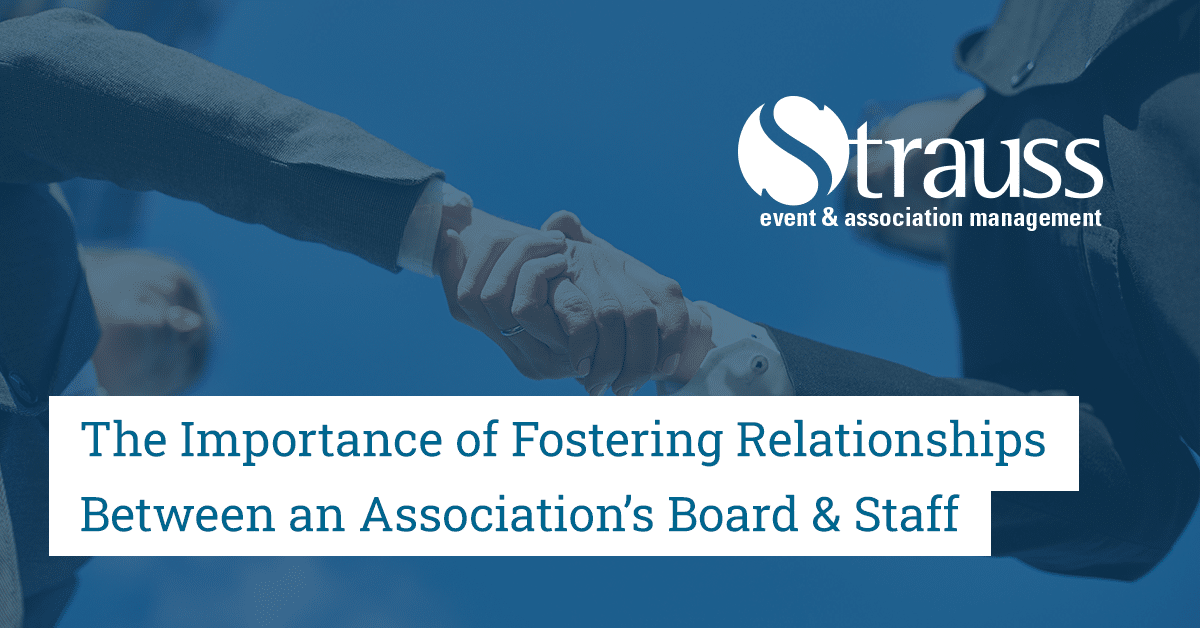“The unique and multifaceted relationship between the board and its executive is perhaps the most important relationship leading to organizational success or failure. Like the two partners in a skating competition, each side can either bring out the best in the other or prevent the other from skating well.” ~ Jan Masaoka, CEO of the California Association of Nonprofits ~
A board-executive partnership that’s healthy and powerful is essential to a high-performing association that is focused on its mission. The dynamics of this relationship set the tone at the top and transcends throughout the entire organization. The healthy and respectful two-way relationship will be visible throughout the entire organization and ultimately encourage all stakeholders of the organization to have a relationship of collaboration versus one with tunnel vision.
Great working relationships are necessary for a high-performing association and staff must strive to develop these partnerships early in the transition phase. This includes ensuring that all parties understand the scope of work and priorities of the organization. A strong and positive partnership between staff and the Board contributes positively to the association’s impact on its mission.
The executive director manages the day-to-day operations of the association. They have authority and accountability for the leadership of the organization’s programs and services. The Board of Directors’ responsibility is to govern the association and support the executive director and staff. I previously wrote about the importance of a strong relationship between the Board chair and chief staff officer in this article.
Key areas to focus on to strengthen the working relationships within an association are:
Communications
Great communications, accountability and transparency are of the utmost priority to create a strong Board/staff relationship. Having clear and consistent communication channels will lead to building stronger working relationships. Responding to emails in a timely manner, committing to regular touch base meetings and picking up the phone to discuss a topic is important for both staff and the Board chair. Regular communication will ultimately lead to an understanding of one another’s expertise and how the migration of each person’s strengths can lead to the successful completion of projects.
Exemplify Trust
It is important to create an environment of trust, respect, and appreciation for roles between the Board and staff. Mutual accountability within the Board and staff relationship is imperative. This then sets the standard for accountability throughout the entire association as a model to follow. In this article, I define the ideal attributes of a great association Board member.
The association members observe the relationships between the Board and staff – and they will mimic them. If the Board often meets privately and discusses operational tasks without the staff, the members will see – and it may cause doubt in the staff’s capabilities. If the Board does not support and recognize the accomplishments of the staff, the members could also doubt the Board’s trust in the staff and begin to come to their own conclusions. By creating an environment of mutual trust and respect, the association will ultimately benefit as all will be on the same page and work cohesively.
Execute Transparency
It’s also important to commit to “no surprises” from the staff or the Board. Maintain clear and open communication channels to discuss all topics that arise that affect the mission of the association. Ensure the partnership is strong and obvious and this will be reflected in the entire organization and staff. The worst thing in an organization is to have an “after the fact” conversation. Like a “we forgot to invite you to a meeting, but we made the following decision…” Transparent, open communication is key!
It is imperative that the Board of Directors and staff have comfortable candor and understand the importance of working together as a team to achieve the mission of the association. Clear communication, understanding of roles and building relationships to be each other’s biggest cheerleaders will provide the organization’s leadership to hit that triple axel in unison and score the “perfect ten”.
To further this point, I recommend you read this article by Jonathan N. Strauss that details the importance of the working relationship between the executive director and the Board. It highlights the exceptional exercises that can be executed to establish a solid relationship and understand everyone’s strengths and how to tap into those and work together to advance the association. https://strauss.ca/the-role-continuum-for-chief-staff-executive-and-board-of-an-association/

